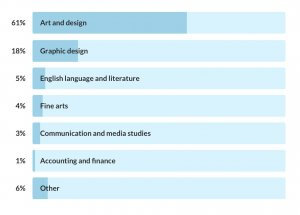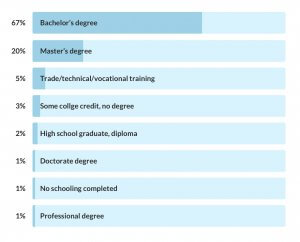Blog •
Last updated on Nov 07, 2023
How to Become a Book Cover Designer: the Master Guide
About Ricardo Fayet
Reedsy co-founder and Chief Marketing Officer, Ricardo Fayet has worked with hundreds of authors on their launches and marketing campaigns. He is the author of two bestselling guides on marketing for authors, and a regular presenter at the largest writers' conferences.
Learn more →About Linnea Gradin
The editor-in-chief of the Reedsy Freelancer blog, Linnea is a writer and marketer with a degree from the University of Cambridge. Her focus is to provide aspiring editors and book designers with the resources to further their careers.
Learn more →This article was written in collaboration with professional book cover designers Caroline Teagle, Michael Rehder, David Provolo, and Patrick Knowles.
If you have a passion for books and design — and want a career that combines both — then you might be wondering how to become a book cover designer. The rise of self-published authors has increased the demand for freelance design professionals, making it the perfect time to join the industry.
Whether you have an expansive portfolio or are right out of college, you’ll find that there are many routes into the book design profession. Below you’ll find everything you need to know about getting started in the industry — straight from professional book cover designers themselves.
But first let’s go back to the basics.
What does a book cover designer do?
Book design is more than just a few illustrations and a splash of typography. It’s about understanding how to properly balance images, text, and information within the limited space of a book’s cover. As a designer, you need to know how to design a cover that is attention-grabbing while also representative of the story within.
The cover of a book also plays the most pivotal role in marketing it is the first thing that potential readers see — their first point of contact with the story. As such, you need to be familiar with the design trends of different genres and ride the fine line between creativity and convention. The cover must stand out while staying true to the tone and expectations of the target audience.
Now, what kind of employment options are available to book cover designers? Let’s take a look.

JOIN REEDSY
Find exciting new projects
We connect publishing professionals with our community of 1,500,000 authors.
What's the difference between in-house vs freelancer book designers?
The most popular career paths for book cover designers come in two molds: in-house or freelance. Both have their pros and cons, so it’s important that you are familiar with them in order to make the best decision for your own future career. Let’s explore a few of their characteristics.
In-House: Pros
In-house designers have been hired by a business to design exclusively for that business alone. For book cover designers, the most common business would be a publishing house, which can range from a small, independent publisher to one of the ‘Big 5’ publishers.
Benefits and a steady pay check
As an employee, you’ll receive the benefits that come with working for a big company. Their success means your success — and a reliable paycheck. You can take vacation or sick time off and don’t have to worry about not getting a paycheck just because you didn’t work for a few days. You may also get benefits such as health insurance and a company-sponsored retirement fund.
Client reliability
By working in a publishing house, you won’t need to go looking for clients. Instead, they will come to you. You might have to give up some creative freedom in the process, since you will have to answer to creative directors, but you’ll always have work waiting for you when you get to the office in the morning.
In-House: Cons
Entry barrier
According to statistics shown by Data USA, there are approximately 786,017 designers in the workforce and, as of 2016, almost 40,000 students graduating each year with design and applied art degrees. Although not everybody will pursue the same industry, this means that the competition for design jobs is anything but easy. If you want to work in-house for a publisher, you might face stiff competition and a harder entry barrier that may at the very least require a university degree just to be considered as a candidate for the job.
Might require relocation
Most of the big publishing houses (and even small ones) are located in big cities. Because working in-house means commuting and following the schedule of a regular work day, you’ll have to move unless you already live in a city like New York or London.
Freelance: Pros
Working as a freelancer means that you get to work for a wide variety of people instead of having one single employer. You are your own boss with no one to answer to, and you make all the business and creative decisions — but your business’ success is entirely up to you.
Control over your own schedule
Since you don’t have to commute or answer to a boss, you are free to work according to your own preferred schedule. This will be particularly beneficial if you already know that your most productive and creative hours aren’t necessarily 9-5. This also means you get control over your work environment — so you are free to play your music as loud as you want!
Creative freedom
While you still need to fulfil the expectations of the authors you are working with, you don’t need to follow anybody’s instructions on your particular design — you have full control over every single creative choice.
Q: How do you best work with clients to capture their vision for their book cover?
Suggested answer
Communication is key. Asking questions and asking for examples of favorite covers is a start.
After that I like to send a few different concepts. I like to make it clear that the first round is still like a shot in the dark and work in progress. Specially when the client is not sure what they want. The best way to understand what a client expectation is, for design and style, is to send a few different options first and start working from there.
Veronica is available to hire on Reedsy ⏺
Firstly, always listen to what the client is saying and - read between the lines - what do they really want. Read the brief. Then read it again. I don't just slavishly give the client exactly what they ask for. They are paying me for my expertise. So I will consider what they want to achieve (which is usually different than what they initially want to see). Then I will come back with ideas that will achieve their aims. Its a bit of back-and-forth between me and the client until we align on the final cover. Clients tell me all the time, they could never have expected the final cover to look how it does, and how thrilled they are with the result. Sometimes a client will come with a firm idea or element. If that serves the book then great, I will incorporate it in a way that optimises what the cover needs to communicate. Its ultimately about communicating clearly with the client.
Wayne is available to hire on Reedsy ⏺
If you're looking for more insights on the benefits of working as a freelance designer, check out Sarah Lahay's story about how she is able to follow the circus around the world.
Freelance: Cons
Bearing the full load
As a freelancer, everything falls on your shoulders. You’d be responsible for getting clients, doing the work, following up on request and payments, and every other business decision. Unless you do the leg work, clients are not guaranteed — and neither is your paycheck. You’ll also be responsible for budgeting your own time off, paying for your own benefits (such as health insurance), and setting up your own retirement fund.
24/7 work load — at least at first
While you are free to control your own schedule and work environment, beginning your career as a freelancer will mean having to work extra-long hours and balancing several jobs at a time in order to make sure you get (and retain) clients. While this gets better over time, starting off will require a lot of hard work.
How to become a book cover designer in 5 steps
There's no one path when it comes to becoming a book cover designer. However, here are 5 tips from professional designers that definitely won't lead you astray if you follow them.
1. Learn the tools
In order to be able to create book covers that are relevant for the target audience, designers need to be constantly evolving and adapting to the ever-changing world of design. So, whether you have a design degree or are self-taught, it is important to stay up-to-date with the latest design tools. Caroline Teagle, for instance, still takes classes at the School of Visual Arts here in NYC:
"I want to focus on developing a particular skill or add some new work to my portfolio that varies from what I do professionally."
Q: How did you learn to design book covers?
Suggested answer
I started out as an assistant at Simon & Schuster and was fortunate to work with some of the most talented cover designers of that era. I paid close attention to what they were doing and what the publicity and marketing people contributed to the conversation.
Taking what I learned, I put together a mock portfolio, which I used to move up into becoming a cover designer and eventually an Art Director at Random House. While still on staff, I created a website and started doing freelance cover design in the early years of indie publishing. Eventually I moved into working with indie authors full time.
Laura is available to hire on Reedsy ⏺
My journey to designing book covers started with learning how to create digital art, and the best place to begin is with photo manipulation. YouTube offers a wealth of tutorials; the key is to find a teacher whose lessons resonate with you. This connection is crucial for maintaining long-term motivation and ensuring you don’t abandon the learning process.
However, a book cover is more than just a compelling image—it also requires skillful text integration. Many aspiring authors try to design their covers themselves, and I completely understand their perspective. Not everyone can afford to hire a professional designer. While authors can generate or purchase images, their inexperience often becomes evident when it comes to working with typography. Poorly chosen fonts and poorly arranged text can detract from even the most stunning artwork.
Typography is a crucial component of a book cover. Even the most professional and captivating art can be ruined by bad typography. Mastering this skill is essential for creating cohesive and polished designs.
Learning how to create digital art and understanding the basics of typography are the first steps to success in this field. Beyond that, the key to growth is practice, training, and observation. In art schools, students are often taken to exhibitions of renowned artists to study techniques, adapt them, and develop their own unique style. This principle also applies to book cover design: seek inspiration without resorting to imitation.
Early in my journey, I participated in numerous design contests. Competing with other designers pushed me to refine my skills, learn from every project, and improve with each win or loss.
Remember, in today's world, knowledge is at our fingertips. All we need to do is seize it, organize it, and stay consistent.
It’s that simple—self-education. With determination, curiosity, and perseverance, you can teach yourself anything, including the art of designing book covers. Keep learning, keep practicing, and never stop growing.
Regards,
Evgeniia
Evgeniia is available to hire on Reedsy ⏺
2. Practice redesigning your favorite books
As designer Michael Rehder says, “Building a great portfolio starts with a passion to do great work for your client — and yourself.” You don’t need to wait until you have a client to begin designing book covers. The best way to practice, build up your portfolio, and show off your design skills is by — surprise, surprise — designing book covers! Even if these designs never make it onto the actual covers of books, your potential clients will be able to see your design abilities through them.
If you're just starting to redesing favorite book covers, don't be afraid to play around with different tools such as typography, illustration and photography, and browse book shops for a better sense of what's on the market.
For more tips to kickstart your career, check out our webinar with designers Asya Blue and Jeff Brown.
3. Market yourself
It might be tough and intimidating, but the best way to get your name out there is by doing the leg work. Make full use of social media by creating a creative profile, where you can upload your best designs for prospective clients to see. In designer David Provolo's own words:
“I designed my first book seven years ago. My career as a book designer didn’t truly blossom, though, until I created an Instagram account dedicated to my book cover design that was noticed by Reedsy.”
Wondering if you're ready to join Reedsy's all-star book designer community? This quiz can give you an answer:
💼
Are you ready to join Reedsy?
Find out here! Takes 1 minute
4. Build a network
In order to be a successful designer, you need to let people know about you and the quality of your work. Building a network will help you get in touch with more clients and broaden your exposure. Get on LinkedIn, go to events, talk to other people in your industry, don’t be afraid of putting your name out there. Keep calm and follow Patrick Knowles' words: “‘Self-belief’ is a bit of a cliché, but it is necessary, and you just have to get out there and do the phone calls and master the art of networking. Most people working in the industry are really friendly but everyone’s so busy, so it’s harder to get to see people nowadays. So, the best bit of advice I would give is never, never, never, never, never give up!”
5. Don't give up
To answer up-and-coming designers FAQs about getting their careers started, we surveyed Reedsy’s professional book designers. As you can see from the results, there isn’t one single path to a job in book design — an industry that is constantly evolving.
Below we see the subjects that our book designers have studied at university:

Although many designers have had formal education in either graphic design or arts, you don't always need to be university-trained to become a successful book designer. When asked about other types of education, e.g. courses or workshops, over 60% of our designers confirmed that they have taken up either on- or offline book design-related courses. Many designers swear by e-learning courses, found on platforms such as lynda.com or Adobe software seminars, which are also helpful for formally trained designers to keep their skills up!
What is the highest degree or level of their formal education?
The majority of designers have only completed a Bachelor's degree, mentioning that the most valuable training came from having the opportunity to do book design work in-house, where they were trained by very experienced designers; as with this type of work, you absolutely learn by doing.
So this is the most important piece of advice that our professional book cover designers can give you: keep learning and keep going. For instance, designer Patrick Knowles’s first job was working as a freelancer for a British children’s non-fiction publisher. He says.
“It was pretty hands-on in those days pre-computer (what?!), so we used magic markers for visualising and ordered up rub-down transfers for mocking up covers for book fairs like Bologna and Frankfurt. Doing everything by hand was good experience as it taught me a lot about using my drawing skills to visualise quickly. Nowadays I nearly always start with pencil ideas before going to the computer.”
Furthermore, most successful design careers don’t start immediately by hitting the ground running.
After graduating with an Art History degree, Caroline Teagle wasn’t sure what she wanted to do for work. She says:
“Shortly after relocating [to New York City] from Charleston, South Carolina I was hired for an administrative assistant position in the cover art department of Doubleday, a division of Random House. It was there that I first became acquainted with the idea of becoming a professional book cover designer. I've always loved reading and literature, so it felt like a great chance to merge that interest with my visual skills.”
Becoming a book cover designer takes a lot of work, but the results are rewarding. Don’t be afraid to put yourself and your work out there, be confident in what you can do, and let your skills speak for themselves.
Q: How did you find paid gigs at the beginning of your career?
Suggested answer
Through all the means you might think. Back in the day, I did gallery art shows, hung out in the art scene, and tabled at art/craft fairs. Now I try to do these things in tandem with doing all the virtual stuff: having a professional website/portfolio and keeping active on social media. Even doing all those things for years and years, I never had consistent paid gigs until Reedsy. Now I am trying to foster this connection and keep learning!
Michael is available to hire on Reedsy ⏺
If you're already a designer or hoping to become one but wondering how to set your rates, check out these 4 pro tips for choosing your freelance designer rates!

